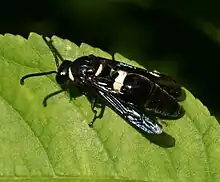| Monobia quadridens | |
|---|---|
 | |
| Scientific classification | |
| Domain: | Eukaryota |
| Kingdom: | Animalia |
| Phylum: | Arthropoda |
| Class: | Insecta |
| Order: | Hymenoptera |
| Family: | Vespidae |
| Genus: | Monobia |
| Species: | M. quadridens |
| Binomial name | |
| Monobia quadridens | |
| Synonyms [1] | |
| |
Monobia quadridens, also known as the four-toothed mason wasp, is a species of solitary potter wasp found in North America. It grows to a wingspan of 18 mm (0.71 in), and feeds on small caterpillars and pollen. Two generations occur per year, with one generation overwintering as pupae.
Description
The abdomen of M. quadridens is entirely black, except for a broad ivory-coloured band on the first tergite.[2] The wingspan is typically 11.0–14.5 mm (0.43–0.57 in) for males, and 14–18 mm (0.55–0.71 in) for females.[2] It closely resembles Euodynerus bidens in size and colouration.[2]
Distribution
Monobia quadridens has a wide distribution in eastern North America. In Mexico, it is found in the states of Tamaulipas and Nuevo León, while in the United States, it is found from New Mexico, Kansas, and Wisconsin east to the Eastern Seaboard.[2] The occurrence of the species in Canada has not been explicitly recorded in print, but specimens identified as M. quadridens have been present in Canadian entomological collections for a long time.[2]
Taxonomy
Monobia quadridens was first described by Carl Linnaeus in his 1763 work Centuria Insectorum, under the name Vespa quadridens.[3]
Life cycle and ecology
Monobia quadridens is bivoltine, having two generations in a year. One emerges in summer, while the other overwinters as pupae before emerging the following spring.[4] Copulation lasts for 30 minutes in M. quadridens, while in most wasp species, it only lasts a minute or two.[5] It nests in a variety of cavities including tunnels abandoned by carpenter bees, old nests built by mud daubers, and hollow plant stems.[2]
The diet of M. quadridens is primarily composed of caterpillars of microlepidoptera, including species from the families Pyralidae, Crambidae, Elachistidae, Amphisbatidae, Gelechiidae, and Tortricidae.[2] The diet also includes a large proportion of pollen.[6]
Sting
Like many wasps, M. quadridens is capable of delivering a sting. The pain caused by the sting of a female is similar to that caused by the bald-faced hornet or the ant Myrmecia nigriceps.[7] Unlike most other wasps, however, the male is also capable of delivering a painful jab like a needle prick, although no venom is injected, so the pain is transient. The male has no stinger and uses the tip of its abdomen.[8]
References
- ↑ Frederick Smith (1857). "Monobia". Catalogue of Hymenopterous Insects in the Collection of the British Museum. Part V. Vespidae. British Museum (Natural History). pp. 41–42.
- 1 2 3 4 5 6 7 Buck, Matthias; Marshall, Stephen A.; Cheung, David K. B. (February 19, 2008). "Identification Atlas of the Vespidae (Hymenoptera, Aculeata) of the northeastern Nearctic region" (PDF). Canadian Journal of Arthropod Identification (5): 222. doi:10.3752/cjai.2008.05. Retrieved June 26, 2018.
- ↑ J. van der Vecht & James M. Carpenter (1990). "A catalogue of the genera of the Vespidae (Hymenoptera)" (PDF). Zoologische Verhandelingen. 260: 1–62.
- ↑ James H. Hunt (2007). "Life cycles in solitary wasps". The evolution of social wasps. Oxford University Press US. pp. 142–162. ISBN 978-0-19-530785-6.
- ↑ Kenneth G. Ross & Robert W. Matthews (1991). "Courtship and copulation". The Social Biology of Wasps. Cornell University Press. pp. 64–66. ISBN 978-0-8014-9906-7.
- ↑ James H. Hunt; Peggy A. Brown; Karen M. Sago; Jennifer A. Kerker (1991). "Vespid wasps eat pollen (Hymenoptera: Vespidae)". Journal of the Kansas Entomological Society. 64 (2): 127–130. Retrieved 15 September 2022.
- ↑ David L. Evans & Justin O. Schmidt (1990). "The physiological and pharmacological basis of venom effectiveness". Insect defenses: adaptive mechanisms and strategies of prey and predators. SUNY series in animal behavior. State University of New York Press. pp. 390–406. ISBN 978-0-88706-896-6.
- ↑ Phil Rau (1934). "The sting of the male wasp, Monobia quadridens" (PDF). Psyche. 41 (4): 245–248. doi:10.1155/1934/96736.